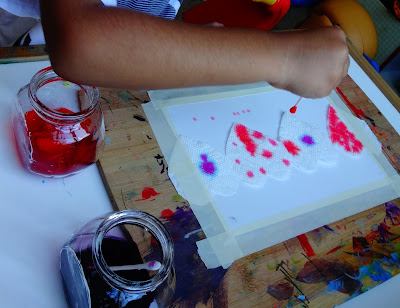We are at the third letter of our Gujarati letter learning, that is letter 'થ'. I did present J with the letter tray to explore by him self and soon we were on our journey of further exploration.
1). 'થડ': We learned about parts of a tree using three part cards by trillium montessori (found here). J could clearly identify the tree trunk ('થડ') and colored it very neatly. He actually enjoys watching colors soaking into a paper until it causes holes and tears, but with this one, he was very careful.
 |
| Parts of a tree by trilliummontessori.com |
2). On our visit to park, we identified 'Smooth' and 'Rough' textures of tree trunks and collected some barks of a pine tree. We used a thick paper to glue on to and J used ('poured!') a lot (the most fun part of this craft) of glue to make them stick, which was tricky due to their bit curvy shape.
 |
| Tree trunk craft |
3). 'થોર' : After we visited our local Lowes store, to look for different varieties of cactus, I had already thought of an afternoon filled with play dough fun. So I gave him some play dough, a plastic knife and fork, a rolling pin, toothpicks cut in halves, a play dough mat. We don't own a laminator yet, so my solution to a play dough mat was, to draw a cactus on a white paper, slide it into a plastic sleeve and tape up the open edge.
 |
| Cactus plants - play dough cactus |
4). The play dough date was more enjoyed every other way, than forming into a cactus and it was much more fun. His play, his way. He can now make a perfect dough ball...Yay! I had never seen him laughing so hard until, after passing a dough ball through a long cylinder. Other than strengthening our hand and finger muscles, we learned about how an object smaller than the hole can only pas through it.
 | |
| Sensory play - play dough fun |
5). We worked on this simple cactus puzzle with sequencing and number recognition (Gujarati-6 to 10). For control of error, I had written both English and Gujarati numbers on the paper at the base. He knew his numbers in sequence and worked on associating them with correct symbols.
 |
| Sequencing and letter recognition |
6). 'થેલી' : We worked on size sorting of these foam bags. J sorted them in small, medium and big and then adjusted the fourth bag where it belonged. Concept of 'bigger than' and 'smaller than' didn't fetch much of an interest, so we agreed on keeping them to three sizes until he shows interest again.
 |
| Size Sorting |
7). Before we concluded our letter 'થ', we talked about the meaning of 'થીગડું' (a patch) and it's uses.
 |
| Letter 'થ' |








































